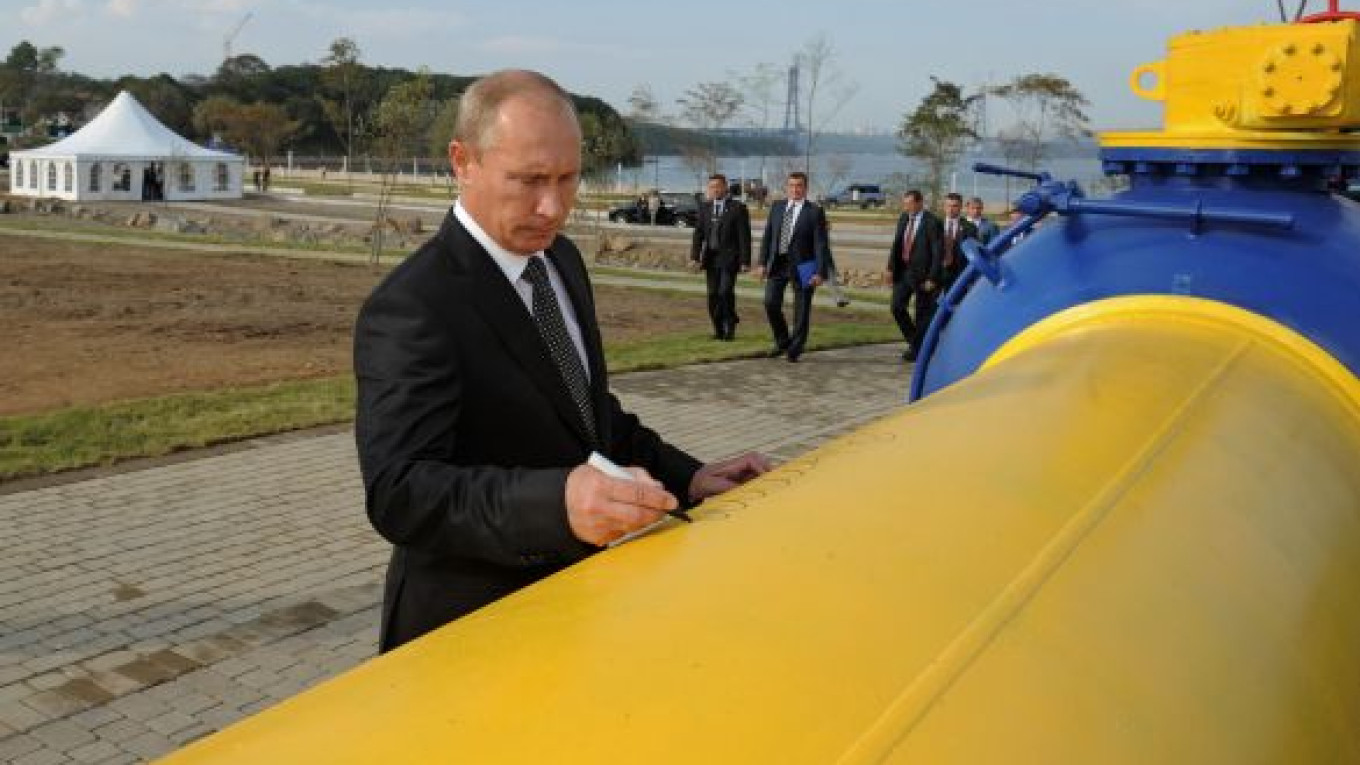Prime Minister Vladimir Putin on Thursday opened a multibillion-dollar pipeline that could potentially boost natural gas exports from Russia to Asia, including through reclusive North Korea.
The Gazprom pipeline takes gas from the Pacific island of Sakhalin to the mainland port of Vladivostok. From there it could travel to Japan, China and South Korea as the project develops.
Initially, there will only be enough gas for domestic needs, and it will encourage new businesses to appear because energy plants will dramatically increase the use of the fuel and generate cheaper electricity, Putin said.
"This creates new conditions for development," Putin said. "From now on, this will enable our large companies to set up new production units and create … new well-paid jobs."
When the pipeline's capacity grows from the initial 6 billion cubic meters to 30 bcm — which Gazprom expects in 2020, according to a leaked pipeline construction plan — the link will acquire an international dimension.
"It will become a major part of Gazprom's and Russia's gas export infrastructure," said Julian Lee, a Russia analyst at the Centre for Global Energy Studies in London.
The issues to resolve before then include either the construction of cross-border pipelines or a plant that will chill the gas into a liquid suitable for transportation by tankers.
Gazprom, the world's largest natural gas company, will also need to spend fortunes tapping new fields in the region to get enough gas flowing.
One export idea being discussed — despite how outlandish it might seem — is to extend the pipeline through North Korea to South Korea, making the buyer hostage to the whims of the totalitarian transit country.
Nevertheless, talks on that option have intensified in the past few months. North Korean leader Kim Jong Il approved the plan during a meeting with President Dmitry Medvedev at a Siberian military base at the end of last month, the Kremlin said. Gazprom executives had flown to Pyongyang in July, and Gazprom chief Alexei Miller met with the North Korean ambassador to Moscow in June.
As an alternative, Gazprom agreed with an Itochu Corporation-led group of Japanese companies in April to assess building a liquefied natural gas, or LNG, plant as Japan seeks additional fuel supplies after its worst ever nuclear accident. The plant could produce 10 million tons of LNG a year, about the same amount as Russia ships abroad annually as part of the Sakhalin-2 project Gazprom is developing with Holland's Shell and Japan's Mitsui and Mitsubishi.
According to U.S. Energy Information Administration, 10 million tons of LNG could equal about 13.7 bcm of pipeline gas.
Tankers filled with liquefied gas leave Sakhalin mostly for Japan. Other destinations include South Korea, India, Kuwait, China and Taiwan.
Gazprom will initially use Russia's share of the gas from Sakhalin-2, which operates under a production sharing agreement, to fill the pipeline to Vladivostok. Some of the gas from the ExxonMobil-led Sakhalin-1 project will also go through the pipeline, Gazprom said.
Gazprom estimated that the Sakhalin-Vladivostok pipeline — when expanded to its full capacity in 2020 — will cost 467 billion rubles ($15.8 billion), according to the leaked pipeline construction plan.
The pipeline, whose construction began in mid-2009, took 196 billion rubles to build this year and last year, the plan said. It did not give the 2009 amount.
Gazprom did not disclose the cost of the pipeline, and calls to the company's press office went unanswered Thursday afternoon. The entire pipeline is 1,830 kilometers long, including a 472-kilometer stretch in the middle that already existed.
Putin reiterated Thursday that Gazprom would embark next year on construction of another giant pipeline in the region, originating in Yakutia. That pipeline would deliver gas from the Chayandinskoye field and join up with the Sakhalin-Vladivostok link near Khabarovsk.
Gazprom plans for the pipeline to eventually carry 60 bcm of gas a year, Miller said in June. The deadline for completing the link was not reported, but Chayandinskoye is expected to come online in 2016.
A Message from The Moscow Times:
Dear readers,
We are facing unprecedented challenges. Russia's Prosecutor General's Office has designated The Moscow Times as an "undesirable" organization, criminalizing our work and putting our staff at risk of prosecution. This follows our earlier unjust labeling as a "foreign agent."
These actions are direct attempts to silence independent journalism in Russia. The authorities claim our work "discredits the decisions of the Russian leadership." We see things differently: we strive to provide accurate, unbiased reporting on Russia.
We, the journalists of The Moscow Times, refuse to be silenced. But to continue our work, we need your help.
Your support, no matter how small, makes a world of difference. If you can, please support us monthly starting from just $2. It's quick to set up, and every contribution makes a significant impact.
By supporting The Moscow Times, you're defending open, independent journalism in the face of repression. Thank you for standing with us.
Remind me later.


